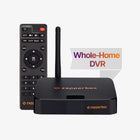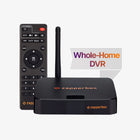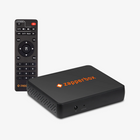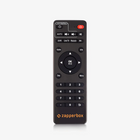Posted Sep 5, 2025
This article is prompted by the launch of our quad tuner. As our quad tuner article “To Quad or not to Quad” points out, there is about an 8dBm signal level drop when you split the signal from an antenna four ways. This got us wondering how large installation like hotels and multi-dwelling units (MDUs) cope with distributing OTA signal from a single antenna to hundreds of rooms? We reached out to Televes and sure enough, they had answers.
It is not surprising that the solutions that apply to MDUs also work for single-family homes. The real problem being solved by these solutions is that at most locations an antenna receives a mixture of strong and weak signals. The worst thing one can do is use a cheap amplifier that amplifies everything by 15 or 30dBm. That will overamplify strong signals and add unnecessary noise.
Many locations also need to combine more than one antenna to receive signals from different directions or combine low-VHF with other bands. The solutions presented in this article accomplish that too.
The next best thing is to use an amplifier like this single input or this dual input model that can combine two antenna inputs. These amplifiers use three different amplifiers for low-VHF, high-VHF and UHF bands and do not overamplify any RF band. This is still a bit of a compromise because the strongest station limits how much the weakest station can be amplified.
The real solution is presented by a pair of Televes products that contain 32 discreet amplifiers that allow you to individually adjust the amplification for up to 32 stations. These products are called the SamrtKom and the Avant X. The former is suitable for single family homes and medium size MDUs and the latter is for large MDUs.
Let’s see how this was done for a large hotel installation. The install starts with the Antennas. These are tri-band Televes antennas with built-in preamplifiers and LTE filters. Each antenna costs around $200 and is available at this link. Since the antenna has its own built amplifier the SmartKom and the Avant X can supply power to the antenna or turn that power off using the accompanying setup app. In the photo below, two antennas are used to receive signals from two different directions, and the signals are combined using the Avant X distribution amplifier.

In the following photo, you can see the antennas on the roof of the hotel.

The antennas feed into a $400 Televes Avant X distribution amplifier, shown below. You can find the Avant X at this link.

Now comes the important part:
- Ensure that each unused RF output or input is terminated with a 75-ohm RF terminator, as shown in this link. This keeps all output equally load-balanced, prevents noise interference, and keeps dust out of the RF connectors.
- The grounding blocks are not shown. Be sure to ground each RF output coming from each antenna with a grounding block like the one shown at this link.
- The Avant X is combining two RF inputs from the antenna and feeding them into a 4-way splitter. You can easily use an 8-way or a 16-way splitter. Just terminate each unused output.
- Use a balanced network so that each end point has the same number of splits. This is important because when you change the amplification for a station the same level will feed to all end points. If on end point has a single split and another has a 16-way split the signal received at each end point will be vastly different and defeat the main purpose of this whole exercise.
The following table shows the key differences between the SmartKom and the Avant X. Note that Televes shows signal levels in dBmV while the ZapperBox uses dBm. dBmV is independent of the load impedance while dBm changes with the load. Since OTA devices present a 75 ohm load we can convert dBmV to dBm using the following formula: dBmV = dBm + 48.75. This article show all signal values in dBm since that is what is shown by the ZapperBox signal meter.
Below is a sample RF distribution network. You can easily drive an 8x16 (128) or 16x16 (256) endpoint install. This means that you can serve 128, 256, or even more homes or apartments with such a system. Just do not forget to terminate unused outputs.
Here is how the maximum amplification works for these products. The Avant X will take any input channel between -69dBm and -9dBm and adjust it to the programmed output level in the unit, which is between -19dBm and 9dBm. The SmartKom will take any input channel between -69dBm and -19dBm and adjust it to the programmed output level between -49 to -24dBm.

Finally, the receivers. You can drive ZapperBox quad, dual or single tuner receivers with such a system. Since a quad tuner will internally split the signal twice, each tuner will lose about 8dBm. However, we test each unit to operate between -86dBm and +6dBm. This allows for a very wide sweet spot to set the optimum amplification.




